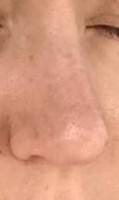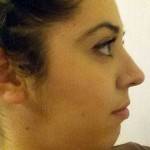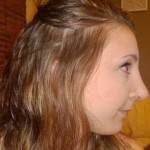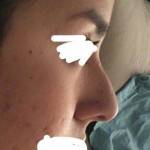Different Nose Shapes Rhinoplasty
Nose shape with rhinoplasty
The final shape of your nose is a collaborative effort amongst you, your surgeon, and your nasal anatomy.
It’s obviously very important for you to communicate your desired nasal shape and appearance to your surgeon.
After a detailed nasal examination, particularly focused on the anatomy of your cartilage, nasal skin thickness, and nasal airway, your surgeon will relay to you what he or she thinks is possible and what is advisable.
His or her aesthetic judgment will obviously play a role, as well as any limitations posed by your nasal anatomy.
That being said, though, all of us listen attentively to the goals and desires of our patients. Most of my patients have realistic and attainable goals and I strive to bring them their desired results. (Sam Jejurikar, MD, Dallas Plastic Surgeon)
Nasal deformities
Rhinoplasty is directed to manage deformities that are already present. For example a nasal hump, a droopy tip or a deviated septum.
Your board certified plastic surgeon will be able to help you identify these abnormalities and could give you a realistic picture on what could be the outcome. (Hisham Seify, MD, PhD, FACS, Orange County Plastic Surgeon)
Shape is limited by anatomy and function
As with any cosmetic procedure, you should discuss your concerns and goals with your surgeon. Some surgeons have digital imaging software where they can illustrate fairly accurately what the end result of surgery might be.
In any case, rhinoplasty surgey is always limited by the underlying anatomy of the patient’s nose and a desire to maintain the function of the nose. At times, a patient’s goals for surgery may not be attainable because they would cause pinching of the nose and difficulty breathing through the nose. (D.J. Verret, MD, Dallas Facial Plastic Surgeon)
You should always discuss your desires, goals and expectations with your surgeon and he/she should tell you whether that is attainable or realistic. Your surgeon should not do something to you, even if it is attainable, but would make you look unnatural. It is not unusual for patients to have unrealistic goals and that is OK because they may not fully understand the surgical process but a consultation is an educational process.
Your surgeon should tell you what can be done, what the potential risks and complications are, what the expected results may be, and what can be done if complications do arise. He should also tell you if you are being unrealistic and in occasional cases may request a psychiatric or psychological evaluation. Do not be offended by this. He is doing this for your best interest and wants you to have the best outcome possible. (Theodore Katz, MD, FACS, Philadelphia Plastic Surgeon)
- The nose shapes for rhinoplasty
- Nose shapes for rhinoplasty photos
- Nose shapes for rhinoplasty operation
- Nose shapes for nose job
The patient and the surgeon together decide on the goal. That goal is a compromise based on what the patient has to work with anatomically and what the surgeon can physically achieve given the limits of techniques and technology. In the end, though, mother nature really has the final say. (David C. Pearson, MD, Jacksonville Facial Plastic Surgeon)
The goal of most cosmetic surgery is to have a happy patient at the end of the process. With this in mind, the final shape of the nose is a collaboration between the patient and the doctor.
What I tell my patient is that we are friends right now, but right after surgery you won’t be happy with me, but we will be friends again in the coming weeks. What I mean when I say this is that right after the surgery, you are swollen and sometimes bruised. With time and healing, my patients are typically very happy. The key is to have a balanced attractive face after you are healed from your surgery. (Sean Wright, MD, Philadelphia Plastic Surgeon)
The decision to undergo rhinoplasty is a personal one. A patient who considers rhinoplasty has usually thought about certain things that they do not like about their nose and want changed. It is true that in the textbooks there are certain ‘ideals’ that one would consider to be a ‘good’ looking nose.
However, this doesn’t necessarily fit with every patient’s needs or desires. On the other side some patients have a particular nose shape in mind which may not be possible. I often get requests to “make my nose look like this actor or actress.”
Sometimes you can get close but it depends on what you are born with. Having realistic expectations and goals depends on close consultation with your surgeon and their comfort level to achieve what you desire.
Sometimes I receive requests for something that I will negatively impact the airway and I will not do that, e.g. making the nose too small. Usually a happy medium can be achieved between what is realistic and your desires to make most patients who undergo rhinoplasty happy. (Samson Lee, MD, Seattle Facial Plastic Surgeon)
Nose shape in rhinoplasty.
You decide on the nose shape for a rhinoplasty, as long as your choice is reasonable and fits your face. An experienced plastic surgeon will give you the necessary guidance.
I would not do a rhinoplasty if a patient wanted a shape that I thought was inappropriate. (George J. Beraka, MD (retired), Manhattan Plastic Surgeon)
Shape of the nose-who decides
It is a mutual decision between you and your surgeon. It is important to realize that a particular shape of the nose cannot be guaranteed. The first goal is to make sure you are not requesting a nasal shape that cannot be obtained surgically or does not fit the general aesthetic principles.
Having said that you can describe your desire to the surgeon. A good way to describe your ideal nose to your surgeon is to pretend you are a plastic surgeon and you can change the nose any way you want.
Then describe in detail what you will change. After that the surgeon will give her/his perspective and then you both reach a common goal NOTE THAT HEALING PROCESS OF THE NOSE CAN CHANGE THE SHAPE OF THE NOSE EVEN MONTHS OR YEARS LATER AND YOU MIGHT NOT GET EXACTLY WHAT YOU ANTICIPATED. (Tanveer Janjua, MD, Bedminster Facial Plastic Surgeon)
Nose shape after rhinoplasty
No doctor can guarantee the final nose shape after a Rhinoplasty nor can they give you a nose that is “exactly like.”. I recommend my patients come in with pictures of noses they like and do not like. Then, I also use digital images of their nose that I can modify to help the patient understand the possible options / outcomes. However, these are all tools for communication, not a guarantee of the final result.
The final product depends on what you start with, what your communicated goals are and the doctors ability. You also have to figure in the variability of healing, compliance, etc. Following the protocol above should go a long way to helping you and the doctor understand each other. (Michael Kulick, MD, San Francisco Plastic Surgeon)




